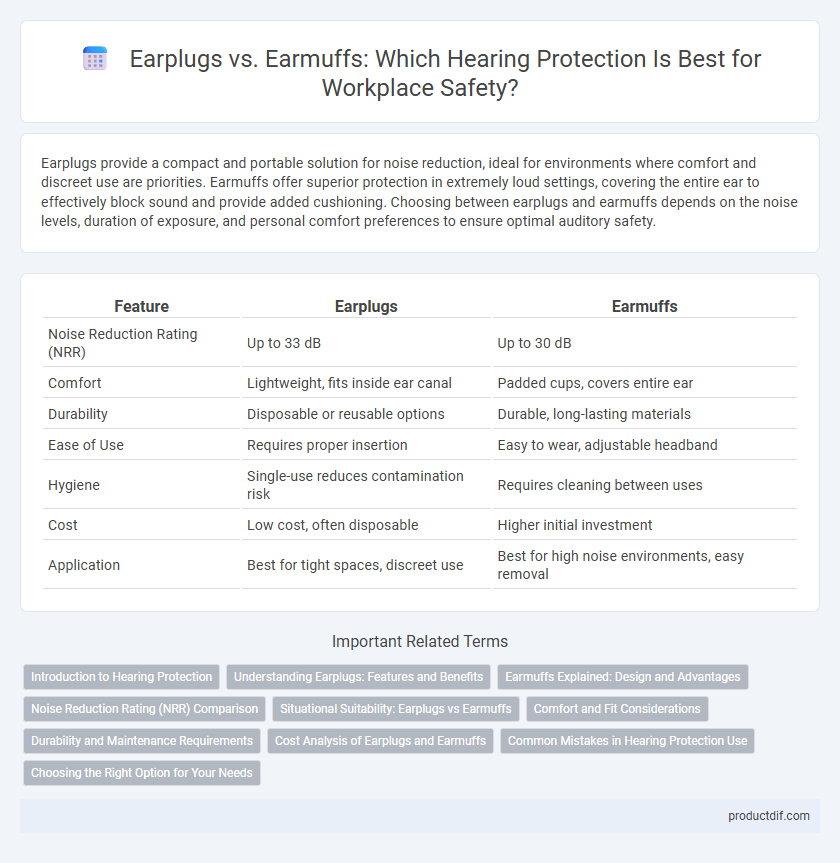Earplugs provide a compact and portable solution for noise reduction, ideal for environments where comfort and discreet use are priorities. Earmuffs offer superior protection in extremely loud settings, covering the entire ear to effectively block sound and provide added cushioning. Choosing between earplugs and earmuffs depends on the noise levels, duration of exposure, and personal comfort preferences to ensure optimal auditory safety.
Table of Comparison
| Feature | Earplugs | Earmuffs |
|---|---|---|
| Noise Reduction Rating (NRR) | Up to 33 dB | Up to 30 dB |
| Comfort | Lightweight, fits inside ear canal | Padded cups, covers entire ear |
| Durability | Disposable or reusable options | Durable, long-lasting materials |
| Ease of Use | Requires proper insertion | Easy to wear, adjustable headband |
| Hygiene | Single-use reduces contamination risk | Requires cleaning between uses |
| Cost | Low cost, often disposable | Higher initial investment |
| Application | Best for tight spaces, discreet use | Best for high noise environments, easy removal |
Introduction to Hearing Protection
Earplugs and earmuffs are essential hearing protection devices designed to reduce noise exposure and prevent hearing loss in loud environments. Earplugs fit directly into the ear canal offering a compact and portable solution, while earmuffs cover the entire outer ear providing a comfortable and easily adjustable barrier. Both types of equipment deliver Noise Reduction Ratings (NRR) that indicate their effectiveness in decibel attenuation, crucial for selecting the appropriate protection based on workplace noise levels.
Understanding Earplugs: Features and Benefits
Earplugs provide a customizable fit by expanding or molding to the ear canal, offering superior noise reduction in noisy environments. Made from foam, silicone, or wax, they are lightweight and portable, ideal for long-term wear during work or sleep. Their discreet design enables users to maintain comfort without sacrificing hearing protection or situational awareness.
Earmuffs Explained: Design and Advantages
Earmuffs feature a sturdy headband and cushioned ear cups that create a seal around the ears, providing effective noise reduction by blocking external sounds. Their adjustable design ensures a comfortable fit for extended wear, making them ideal in high-noise environments such as construction sites and industrial settings. Earmuffs offer superior protection compared to earplugs in situations requiring consistent noise attenuation and are easier to clean and maintain.
Noise Reduction Rating (NRR) Comparison
Earplugs typically offer a Noise Reduction Rating (NRR) ranging from 22 to 33 decibels, making them highly effective for blocking high-frequency noise in industrial and construction settings. Earmuffs generally provide an NRR between 20 and 30 decibels, with some models featuring advanced materials that enhance low-frequency noise attenuation. When selecting safety equipment for hearing protection, consider the specific noise environment and comfort to optimize overall noise reduction performance.
Situational Suitability: Earplugs vs Earmuffs
Earplugs provide a compact, lightweight solution ideal for high-mobility tasks and hot environments, offering discreet noise reduction and better compatibility with eyewear and helmets. Earmuffs deliver superior noise attenuation in extremely loud settings and are easier to remove and replace frequently without contaminating hearing protection. Selecting between earplugs and earmuffs depends on factors such as environmental noise levels, comfort preferences, and the specific work conditions requiring situational suitability.
Comfort and Fit Considerations
Earplugs offer a customizable fit by molding to the ear canal, providing lightweight comfort ideal for extended use and active work environments. Earmuffs feature adjustable headbands and cushioned ear cups that distribute pressure evenly, reducing discomfort during prolonged wear. Both options require proper sizing and placement to ensure optimal noise reduction and prevent irritation.
Durability and Maintenance Requirements
Earplugs typically require frequent replacement due to their disposable nature and are susceptible to wear and tear from repeated use. Earmuffs offer greater durability with robust construction, often featuring replaceable cushions and washable components for extended lifespan. Maintenance for earmuffs involves periodic cleaning and cushion replacement, while earplugs demand proper hygiene and timely disposal to maintain effectiveness.
Cost Analysis of Earplugs and Earmuffs
Earplugs typically offer a lower initial cost compared to earmuffs, making them a budget-friendly choice for personal hearing protection. Earmuffs, while more expensive upfront, provide long-term durability and reusable benefits that can offset their higher price over time. Cost analysis should also consider factors like replacement frequency, maintenance, and the level of noise reduction required for specific safety environments.
Common Mistakes in Hearing Protection Use
Common mistakes in using earplugs and earmuffs include improper insertion or poor fit, which significantly reduces their effectiveness in noise reduction. Many users fail to clean earplugs regularly, leading to hygiene issues and potential ear infections, while earmuffs can lose their seal if the cushions are damaged or worn out. Neglecting to wear the hearing protection consistently during exposure to loud environments compromises safety and increases the risk of noise-induced hearing loss.
Choosing the Right Option for Your Needs
Earplugs offer a compact, lightweight solution ideal for high noise environments such as construction sites, providing up to 33 dB noise reduction with proper insertion. Earmuffs deliver consistent protection and comfort for extended wear, especially in fluctuating temperatures, with noise reduction ratings ranging from 20 to 30 dB. Selecting the right option depends on factors like noise level, duration of exposure, comfort preferences, and compatibility with other safety gear.
Earplugs vs Earmuffs Infographic

 productdif.com
productdif.com